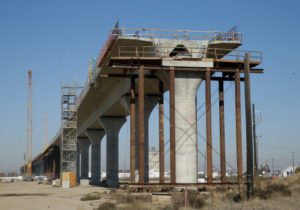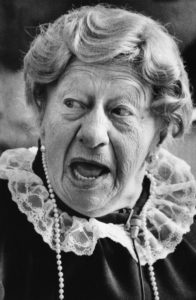Advertising experts say fewer words are often more effective than lengthy descriptions. Some of the most famous ad campaigns have featured short slogans, such as “Got Milk?,” “King of Beers,” “Breakfast of Champions,” “Have it Your Way,” and even the single word “Uncola.” One of the most famous was the 1984 Wendy’s campaign featuring Clara Peller, an old lady demanding more from fast-food chains with the catch phrase, “Where’s the Beef?” Thirty-four years later, the phrase is still commonly used to question the veracity of almost any claim.
 It is being asked regularly in California these days about the promised high speed rail system. That State’s voters approved a measure in 2008 calling for a 200 mile-per-hour bullet train connecting Los Angeles to San Francisco. The understanding was that a third of the money would come from State bonds, a third from the federal government, and a third from the private sector. The total cost was to be about $35 billion. Voters authorized $9 billion in State bonds, and the federal government kicked in the first $3 billion of its share from Obama “stimulus funds.” The federal government eventually bailed on its remaining share of the project, leaving the State on its own, and there has been virtually no private sector money. So in 2014, the additional share was committed from a State environmental program, which generates revenue by auctioning off air pollution permits. The California High Speed Rail Authority (CHSRA), in charge of building and operating the system, has already burned through at least $2.5 billion of the money. It has a website with information in English, Spanish, Chinese, Hindi, and Armenian, but there is no train.
It is being asked regularly in California these days about the promised high speed rail system. That State’s voters approved a measure in 2008 calling for a 200 mile-per-hour bullet train connecting Los Angeles to San Francisco. The understanding was that a third of the money would come from State bonds, a third from the federal government, and a third from the private sector. The total cost was to be about $35 billion. Voters authorized $9 billion in State bonds, and the federal government kicked in the first $3 billion of its share from Obama “stimulus funds.” The federal government eventually bailed on its remaining share of the project, leaving the State on its own, and there has been virtually no private sector money. So in 2014, the additional share was committed from a State environmental program, which generates revenue by auctioning off air pollution permits. The California High Speed Rail Authority (CHSRA), in charge of building and operating the system, has already burned through at least $2.5 billion of the money. It has a website with information in English, Spanish, Chinese, Hindi, and Armenian, but there is no train.
The project has dominated California politics, and national debates on transportation and climate change, for a decade. At the time, Congress was debating a national “cap-and-trade” scheme, but ultimately realized it was a bad idea. Not for California’s “Governor Moonbeam,” Jerry Brown, though. He and his legislature implemented it anyway at the State level, linking it to his other big dream, the high speed train. They committed a fourth of the money from cap-and-trade permits to the train project.
That seemed semi-plausible to Californians at the time, but many are increasingly skeptical now. First, it has not generated the revenue promised, and second, cap-and-grade is still a bad idea. It is supposed to reduce greenhouse gas emissions by making it costly to pollute the air. It caps the amount of total pollution allowed, so companies whose business would increase emissions (new power plants, factories, gravel quarries, etc.) must purchase pollution credits from others who have reduced emissions. That does not stop pollution, of course; it creates a valuable market for it. Consider that if the right to pollute can be bought and sold, and the amount of pollution is capped, then that right has tremendous value. The trading of these “carbon offsets” also require State permits, so the State auctions those permits to the highest bidder, raising millions in revenue. That is the source of funds dedicated to the still-unbuilt high speed rail system.
The cap-and-trade program is central to California’s morbid plan to reduce its emissions to 1950s levels, and Brown considers it vital to his legacy. He leaves office in January, so he convinced the legislature to extend the program through 2030. That deal required the votes of some Republican members, most of whom oppose the train project. So, a compromise was reached, giving the legislature the ability to veto expenditures of cap-and-trade funds, though not until 2024. Meanwhile, there is still no train.
In fact, a new business plan from the CHSRA now projects a cost of $77 billion, a 20 percent increase from two years ago, and admits that cost could rise as high as $98 billion. It also pushed back the estimated completion by several years, to 2033. CHSRA blames funding shortages, naturally, and its CEO resigned. The cap-and-trade revenue to date totals about $958 million, less than one percent of the total projected cost. Even so, it’s a lot of cash, and voters are wondering where all that money has gone, since so little actual construction can be seen anywhere.
Politicians must continually relearn the lesson, that promises and words alone are not enough for most people. In the 1984 presidential campaign, Senator Gary Hart had gone from dark horse to front-runner over Vice President Walter Mondale, because he kept talking about “new ideas.” When Hart used the slogan in a televised debate, Mondale leaned forward and said, “When I hear your new ideas, I’m reminded of that ad – Where’s the beef?” Afterwards Hart began showing up with stacks of policy papers and countering, “Here’s the beef.” But Mondale had cast doubt on Hart’s substance, and it helped gain Mondale the Democratic nomination.
California leaders pushing the high-speed train seem almost as cynical as the Hart campaign, hinting to voters, “just trust us, this is going to be great, you’ll see later.” Brown and other backers hope that by 2024 construction will be so far along that the public will demand legislators stick with it, no matter the cost. Critics, citing its notorious delays and cost overruns, predict that it will be such a mess voters will want it killed. What seems obvious is that California’s next governor, not Brown, may decide the project’s fate.
I have no involvement in California election campaigns, but if I were advising candidates, I might encourage constant repetition of the simple question, “Where’s the train?”
A version of this column appeared in the Grand Junction Daily Sentinel August 10, 2018.





Comments on this entry are closed.